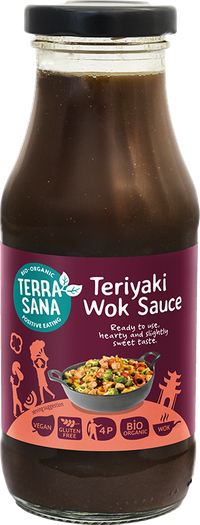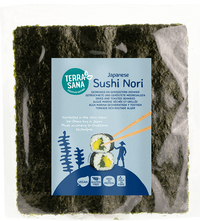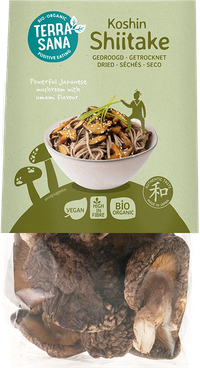How do you use TerraSana’s ready-made umami sauce? Which umami recipes will you have in your recipe vocabulary from now on? Whether you go for umami noodles, umami sushi, umami sandwich fillings or umami bowls, ready-made umami sauce makes it easy for you!
Recipes with umami sauce
Umami sushi
Sushi is fairly umami by nature (the seaweed and soy sauce, for example). Still, feel free to take it a step further. For example, dip your sushi nicely in umami sauce instead of soy sauce. This is slightly less salty than soy sauce because it is more umami. If you still miss the saltiness, mix the umami sauce with a little tamari. Now that’s trendy sushi!
You can also use the umami sauce in a different way, for instance by giving the rice a little umami flavour. In that case, use a mix of genmai su (brown rice vinegar) and umami sauce.
Umami bowls
You know those tasty savoury bowls full of different vegetables and colours? Did you know that making your own quinoa bowl, buddha bowls and poke bowls doesn’t have to be complicated or a lot of work at all? The trick is to choose the right sauces and marinades. Leave that with this umami sauce which is fast and easy in use!
What is the difference between a poke bowl, quinoa bowl and a buddha bowl?
Poke bowl
A traditional Hawaiian dish, the poke bowl has been influenced by Japanese cuisine over the years. In the poke bowl as you know it today, the ingredients look a lot like sushi. The base is sushi rice; that’s what you fill your bowl with. The different ‘sections’ in the bowl usually consist of raw fish, such as tuna and salmon, combined with vegetables like cucumber, seaweed (wakame and nori), edamame and avocado. If you do it the vegan way, you quickly end up with tofu.
The sauces accompanying a poke bowl are very decisive. A combination of a (vegan) mayonnaise with wasabi or sriracha, soy sauce or ponzu (a lighter soy sauce with citrus) are most common.
Sesame and chilli toppings are also quite Japanese. Think togorashi (a chilli pepper mix), furikake (sesame and seaweed) or gomasio (sesame and salt). The rice can be served either hot or at room temperature, the toppings of a pokebowl are usually chilled.
Quinoa bowl
In a quinoa bowl, (the name says it all) quinoa is the base of the dish. You cook the quinoa and serve it in a bowl. You combine that with an array of vegetables, proteins, healthy fats (avocado or nuts) and a dressing or sauce of your choice.
Quinoa bowls are nutritious and versatile, a kind of mix-and-match of healthy ingredients. You eat quinoa warm, at room temperature or cold.
Buddha bowl
A buddha bowl is similar to the quinoa bowl, but the base can also consist of other (ancient) grains. Think buckwheat, millet, couscous, bulgur or spelt. The vegetables, proteins and sauce are again entirely up to you. Buddha bowls are usually vegetarian or vegan, so fish or meat plays a lesser role than in, say, a poke bowl. And: the more colourful, the better!
Why the name Buddha for a buddha bowl? There are several ideas about that. Some say the name buddha bowl comes from how it looks: a bowl full of food with different colourful ingredients arranged in sections, resembling the full belly of a Buddha statue. The idea is actually that it looks like the round shapes you see with such a statue. So there is no official link between this recipe and Buddha, but the bowl full of nutritious food refers to the balance and abundance associated with Buddha’s teachings of well-being and harmony. A buddha bowl conveys the idea of balance and health.
How to make the perfect umami bowl – our tips
Umami is a theme for poke bowls, quinoa bowls and buddha bowls. The more umami you can incorporate into them the better. Here are our practical tips on how to do it:
- Make sure your proteins are marinated in the right amount of umami. Our umami sauce is of course the quickest way, but soy sauce, teriyaki, rice vinegar, mirin and sesame oil also provide balanced umami flavours.
- Choose ‘umami vegetables’. Think seaweed like wakame, arame or pieces of nori.
- Play with sauces. Mayonnaise is smooth and creamy, but make it more umami by adding a little miso or wasabi. TerraSana umami sauce can even be poured right over your poke bowl or buddha bowl. The combination of the creaminess of mayonnaise and the saltiness and umami of, for example, ponzu, tamari, shoyu or umami sauce completes a poke bowl.
- Make your toppings as umami as possible. By toppings, we mean the garnishes. Sesame is also a bit umami. Furikake and gomasio both do super well in a poke bowl.
- Make sure you have a balanced bowl. Create a harmonious mix between different flavours and textures. Make sure you have all five flavours in your bowl.
Umami noodles
Want to make your emergency dish extra umami? There are several ways to do that. Once you realise how delicious the umami flavour makes your noodles, this will become your standard use in the kitchen:
Making Umami sauce
- Use umami sauce, then you don’t really need to add much else. This already contains an optimal amount of umami (level 1).
- Use tamari soy sauce as a base, and complete the sauce with sesame oil and lemon juice or yuzu. (level 2)
- Use tahini or peanut butter as a base, and make the sauce completely umami with tamari soy sauce, sesame oil and a little lemon juice or genmai su. (level 3)
Choosing Umami vegetables
- Use vegetables that naturally contain umami or in which you can easily bring out the umami flavour. Think mushrooms, seaweed and algae or tomatoes.
- When preparing, add umami sauce to the vegetables to flavour them.
Umami on bread
If you like to make your own savoury sandwich fillings, umami sauce is a fine tool to make it work anytime. Do you use umami sauce as a seasoning, for example instead of salt and spices? Then you probably won’t need much more than 1 or 2 tablespoons of umami sauce. To give sandwich fillings a nice kick, a drizzle is all you need.






